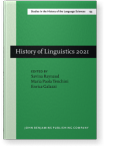Chapter 2
Type or descent?
The philosophical, romantic, and biological sources of typology in Soviet linguistics
of the 1920s–1940s
Either science aims at universal validity, or it is no science. The idea that science can be
culturally or nationally determined is unanimously considered as an outdated Romantic cliché. Nonetheless, it is usual
to speak of the Western thought, without wondering where its Eastern limit is to be found. In the history of
linguistics, Russian science of language is often proclaimed by Russian thinkers as being “fundamentally different”
from Western linguistics. This paradox is examined here after R. Jakobson’s works in the interwar period and their
links to Goethe’s and Naturphilosophie research in biology: idealistic morphology appears to be a way
towards typology.
Keywords: function, Goethe, Jakobson, metaphor, metonymy, Naturphilosophie, Russian linguistics, teleology, tradition, typology, Western thought
Article outline
- 1.Introduction
- 2.Absolute Russian specificity
- 3.The enigma of similarity
- 4.On the sources of typology: Similarity without a common ancestor
- 5.The theory of types
- 6.Metaphor and metonymy
-
Notes
-
References
This content is being prepared for publication; it may be subject to changes.
